platformer
Donkey Kong Country Returns
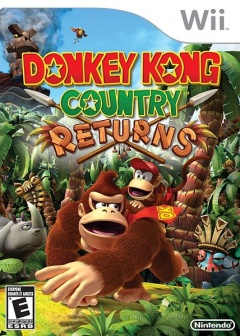 If you were to ask me what game I was most excited for following the events of E3 2010, my answer, without a doubt, would have been Donkey Kong Country Returns. It's announcement marked the return of one of my favourite platforming franchises of my youth—and something I hadn't experienced in years. In the E3 trailer, I noticed the hairy ape brought back all of his signature abilities, plus a couple of new tricks. I saw old friends Diddy and—in later trailers—Rambi make a return. I saw vine swinging, barrel blasting, and mine carting. I saw banana grabbing, KONG letter finding, plus new items to collect. In fact, after seeing what I saw, to say I was excited would've been an understatement; I was overwhelmed with anxious anticipation; I couldn't wait to get my hairy paws on this game.
If you were to ask me what game I was most excited for following the events of E3 2010, my answer, without a doubt, would have been Donkey Kong Country Returns. It's announcement marked the return of one of my favourite platforming franchises of my youth—and something I hadn't experienced in years. In the E3 trailer, I noticed the hairy ape brought back all of his signature abilities, plus a couple of new tricks. I saw old friends Diddy and—in later trailers—Rambi make a return. I saw vine swinging, barrel blasting, and mine carting. I saw banana grabbing, KONG letter finding, plus new items to collect. In fact, after seeing what I saw, to say I was excited would've been an understatement; I was overwhelmed with anxious anticipation; I couldn't wait to get my hairy paws on this game.
And now, the day was finally here; November 21, 2010. I woke up bright and early, refreshed, and ready for a full day of barrel blasting, ground pounding, tiki crushing fun. I set out and purchased the game at a local EB Games outlet about one minute after opening. I was their first customer. I rushed home, popped open the case, threw the disc into the Wii, and fired it up–all the while singing the DK Rap in my excitement (I wish I was joking).
The game features two control options–Wiimote plus nunchuck, and classic Wiimote. I choose the classic style and begin my session...
Sonic Colors
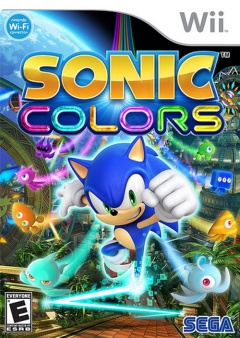 Hi everybody. My name is Nate, and I'm a disgruntled Sonic fan.
Hi everybody. My name is Nate, and I'm a disgruntled Sonic fan.
I was five years old when my dad brought home a Sega Genesis with Sonic the Hedgehog 2. That game was like catnip to me: its lightning speed, vibrant colors, and catchy soundtrack were all I could think about through elementary school. The only reason I put down Sonic 2 for good was my migration to its sequel duo, Sonic 3 & Knuckles. Catnip was now crack: I was hooked for life. I loved the game then, but it wasn't until years later that I realized the genius of S3&K. The sprawling, interconnected stage designs were like races on the playground: your goal was to get from one end to the other, but you could do so in dozens of unique ways. I still play the game annually, and even after so many trips from the beach of Angel Island to the Death Egg in outer space, I can still find new secrets by experimenting with the physics and stage design in ways I hadn't thought of before.
Fast forward to the launch of the Dreamcast, when Sonic Adventure started a new era for for the blue blur. New playable characters, new gameplay modes, cutscenes and spoken dialogue...all in 3-D, of course. And while the addition of a dimension provided the potential for even more spacious stages, the final product was a far more restricted affair than its 2-D predecessors. Gone were the intermingling tunnels and paths, replaced by a string of land strips that were suspended over an endless chasm. I dug the thrilling dashes through those corridors for a while, but I now I only realize how many flaws I overlooked in those days when I replay Sonic Adventure, its sequel, and its successors.
It's been over a decade since the franchise changed course, and while Sega recently made an attempt to recapture the Genesis style, I just don't see the same brilliance in Sonic the Hedgehog 4 that made its prequels so timeless. On the other hand, 3-D Sonic's roller coaster runs have been tampered with throughout the years -- rarely for the better -- and the most recent experiment is Sonic Colors. It sure doesn't appear to be what I want from a Sonic game, but I'll admit that it looks like a huge improvement over the rest of the Adventure-spawn. I decided to give it a chance, something I swore I wouldn't do after Sonic's Arabian Nights-inspired adventure broke the camel's back. Was my change of heart warranted, or am I simply a glutton for punishment?
Kirby's Epic Yarn
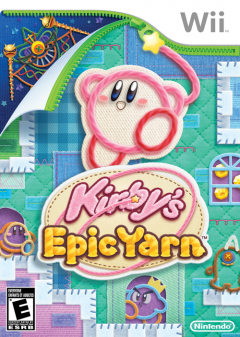 Attendees of the 2010 Electronic Entertainment Expo were witness to many exciting announcements on June 15th during Nintendo’s press conference—one of them being the highly awaited return of Kirby to home consoles. This would mark Kirby’s first appearance on a home console since 2003’s Kirby Air Ride for the Gamecube, and his first platforming adventure since 2000’s Kirby 64: The Crystal Shards. It clearly had a lot to live up to. But alongside roaring applause, the announcement was met with many raised eyebrows regarding our pink hero’s return—for he had undergone a change the likes of which a Nintendo mascot hasn’t seen since Paper Mario. Kirby was made of yarn. Yes, yarn. And his new game, Kirby’s Epic Yarn, would see him battle across a world of felt and fabric against a new foe, and with a new friend. Nevertheless, everyone was excited and anxiously awaiting its release. So, did Nintendo weave the world a masterpiece (yes, I just said that)?
Attendees of the 2010 Electronic Entertainment Expo were witness to many exciting announcements on June 15th during Nintendo’s press conference—one of them being the highly awaited return of Kirby to home consoles. This would mark Kirby’s first appearance on a home console since 2003’s Kirby Air Ride for the Gamecube, and his first platforming adventure since 2000’s Kirby 64: The Crystal Shards. It clearly had a lot to live up to. But alongside roaring applause, the announcement was met with many raised eyebrows regarding our pink hero’s return—for he had undergone a change the likes of which a Nintendo mascot hasn’t seen since Paper Mario. Kirby was made of yarn. Yes, yarn. And his new game, Kirby’s Epic Yarn, would see him battle across a world of felt and fabric against a new foe, and with a new friend. Nevertheless, everyone was excited and anxiously awaiting its release. So, did Nintendo weave the world a masterpiece (yes, I just said that)?
Editor's Note: If you're interested to see how Kirby's Epic Yarn starts, check out Nate's first hour review of the game (and his overall conclusions at the end of the article).
Sonic the Hedgehog 4 - Episode 1
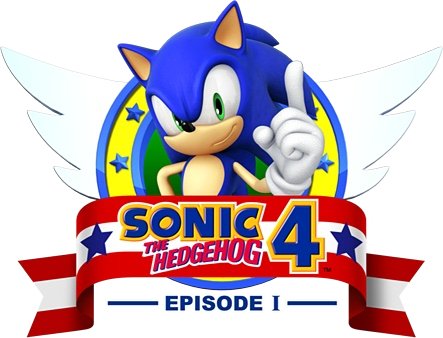 The gaming world first learned of Sonic the Hedgehog 4 back in September of 2009, under the code name “Project Needlemouse”. Sega declared a return to the franchise’s 2D roots, promising the Sonic game old-school fans have been anxiously awaiting for years. Well, there’s no doubt that if you spent the better part of your Saturday mornings as a child dashing through shuttle loops, this is definitely the Sonic game for you.
The gaming world first learned of Sonic the Hedgehog 4 back in September of 2009, under the code name “Project Needlemouse”. Sega declared a return to the franchise’s 2D roots, promising the Sonic game old-school fans have been anxiously awaiting for years. Well, there’s no doubt that if you spent the better part of your Saturday mornings as a child dashing through shuttle loops, this is definitely the Sonic game for you.
Sonic 4 picks up where the blue blur left off 16 years ago in Sonic & Knuckles, for the Sega Genesis. Dr. Eggman (or Robotnik, if you prefer) is up to his old tricks, and it’s up to none other than the fastest thing alive, Sonic the Hedgehog, to stop him; chasing the evil scientist through 4 zones (3 acts each, plus a boss battle) before a final showdown against the doctor’s ultimate creation...
Editor's Note: Jonathan is a brand new writer and contributer to The First Hour. Please welcome him! This review was originally posted at IGN.
Kirby's Epic Yarn
 The word "epic" sees plenty of use these days. You'll find it on plenty of video game boxes, woven into a bullet point or two on the back between screenshots and numbers pulled from reviews. You'll see it in a few game company logos, as well. And sometimes, the word will flash in your mind when you play something otherwise indescribable.
The word "epic" sees plenty of use these days. You'll find it on plenty of video game boxes, woven into a bullet point or two on the back between screenshots and numbers pulled from reviews. You'll see it in a few game company logos, as well. And sometimes, the word will flash in your mind when you play something otherwise indescribable.
It seems "epic" has truly made it big this year, finally being promoted from the back of the box to the title. Not only has the game formerly codenamed "Epic Mickey" been finalized as "Epic Mickey," but Nintendo announced and released their own titanic mega-game worthy of the term: Kirby's Epic Yarn.
Wait, seriously?
That's right, a series that has seen the words Squeak, Dream, and Tumble in its marquees is now Epic. And made of yarn. The title, of course, is a play on the word "yarn" used as a story and also the fact that everything in the game is made of fabric and knitting. But those same reviewers whose five-stars and upward-thumbs sit alongside the word on so many rear covers are giving a game that ironically uses it on the front the same treatment.
I played an hour (and then some more). Would Nintendo want to put my words on the back of the box?
Limbo
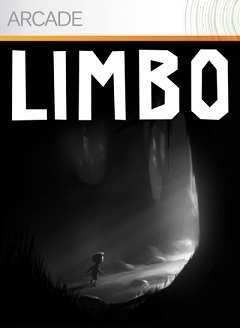 Theologically, limbo exists as a state of divine neutrality, a residence
between heaven and hell. Limbo by Playdead Studios displays this fuzzy
pseudo-reality in its presentation, but with a sinister twist. This
limbo can be cruel, grewsome and even downright evil. Bear traps randomly lie on the
ground, forever waiting just for you alone to trigger them. Giant spiders
hide in caves, hoping you'll wander close enough for them to skewer with their giant
legs. In Limbo, ghost children satisfy their concept of play by setting
up guilottines and buzzsaws to shred you. This game is in no way particularly kind.
Theologically, limbo exists as a state of divine neutrality, a residence
between heaven and hell. Limbo by Playdead Studios displays this fuzzy
pseudo-reality in its presentation, but with a sinister twist. This
limbo can be cruel, grewsome and even downright evil. Bear traps randomly lie on the
ground, forever waiting just for you alone to trigger them. Giant spiders
hide in caves, hoping you'll wander close enough for them to skewer with their giant
legs. In Limbo, ghost children satisfy their concept of play by setting
up guilottines and buzzsaws to shred you. This game is in no way particularly kind.
However, that cruel nature only adds to the atmosphere as the player must remain constantly aware of the presense of death in this bizarre, mysterious minimalist world. In this world and state of existence, death is the norm. Beginning as a stylistic proof of concept by a disgruntled game artist named Arnt Jensen, the concept soon flourished into a full game as Jensen subsequently co-founded Playdead Studios with Dino Patti to develop his idea. Originally planned for a PC release, Playdead was able to procure Dutch government grants and investor support while eventually deciding on an Xbox Live Arcade release, likely to avoid piracy worries and possibly for 360 exclusivity bonuses provided by Microsoft. The game eventually released this summer on July 21st during the 360's "Summer of Arcade." So, how does the final product match atmosphere and action? Does the constant presence of death help or hurt player mood and motivation? Let's take a deeper look and try to decide.
Trine
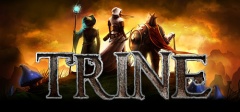 Trine is the kind of game you can't help but wish came along more often, as a rare legitimate platformer. Frozenbyte (along with certain notable indie developers) shows us that 2d platforming is in fact not dead and can be pushed as far as you'll willing to take it. Perhaps most impressively, Trine is in elite company as one of the few download-centric titles that could be mistaken as a traditional retail release.
Trine is the kind of game you can't help but wish came along more often, as a rare legitimate platformer. Frozenbyte (along with certain notable indie developers) shows us that 2d platforming is in fact not dead and can be pushed as far as you'll willing to take it. Perhaps most impressively, Trine is in elite company as one of the few download-centric titles that could be mistaken as a traditional retail release.
For example, check a screenshot of some random game. You likely see an area with a background, or maybe walls or repeating buildings. Perhaps an enemy or two are in the frame and an interactive objects of note. Now take a look at random screenshot of Trine. You see a struggling forest that has been encroached on by both technology and a plague of death. The foreground partially hides you in sparse blades of grass, a handful of flowers, and a large warped tree root. In the background, multiple metallic gears are encrusted into the hill, which is itself overlooked by a towering mountain. The sunlight beaming from above onto wild mushrooms is nothing but welcoming as your knight just escaped from the cave and is heading to a well-constructed but still wobbly bridge up ahead. While one could say such lush descriptions could be extrapolated out of any image; to me, the difference is clear. Trine tries to feed your imagination and create an organic, living environment. While the experience does not stay fully fresh the entire way, Trine has more than enough creativity and character to deserve a second look, as noted in our earlier first hour playthrough.
Mega Man X8
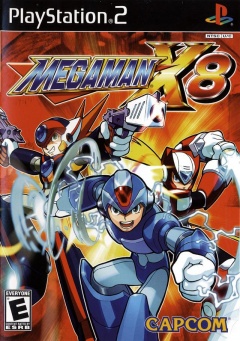 The second video game I ever played was Mega Man 2. Since then, I've
finished twenty-eight games with "Mega Man" in the title, most of them
multiple times. I was the sixth person in the United States to submit a
game completion time to the leaderboards in Mega Man 9, the afternoon it
was released. I was fifth in Mega Man 10. I beat Mega Man 9 without
taking any damage, earning the "Mr. Perfect" in-game challenge title.
I'd even go so far as to say Mega Man 9 was my favorite release in
2008, a year packed with great titles that don't look like they were made twenty years ago and forgotten in a time capsule somewhere.
The second video game I ever played was Mega Man 2. Since then, I've
finished twenty-eight games with "Mega Man" in the title, most of them
multiple times. I was the sixth person in the United States to submit a
game completion time to the leaderboards in Mega Man 9, the afternoon it
was released. I was fifth in Mega Man 10. I beat Mega Man 9 without
taking any damage, earning the "Mr. Perfect" in-game challenge title.
I'd even go so far as to say Mega Man 9 was my favorite release in
2008, a year packed with great titles that don't look like they were made twenty years ago and forgotten in a time capsule somewhere.
I enjoy Mega Man, you guys. Like, kind of a lot.
Because
I didn't have a PlayStation 2 until a few months ago, I missed out on
two titles released exclusively on that system, Mega Man X7 and Mega Man
X8. I recently came across the latter in the bargain bin of a local
game shop, so I figured I'd give it a shot. The Mega Man X series had
started to lose its way by the sixth game (my least favorite game in the
series, oh no!) but I had heard good things about X8.
I was understandably excited to start a relatively new Mega Man game for the first time. So how did the first hour go?
DK: Jungle Climber
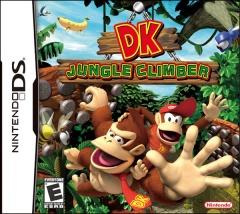 One of the more common complaints you'll hear from Nintendo ex-fans is
that the Big N hasn't made any new franchises in a very long time. For
evidence, critics often point to Super Smash Bros. Brawl,
the game that has become a showcase for iconic Nintendo characters past
and present, and correctly note that none of the game's playable
characters are from a franchise created after 2001's Pikmin.
You'd think the one game that celebrates the whole history of
Nintendo's creations would put some recent stars at the forefront, and
yet there are none.
One of the more common complaints you'll hear from Nintendo ex-fans is
that the Big N hasn't made any new franchises in a very long time. For
evidence, critics often point to Super Smash Bros. Brawl,
the game that has become a showcase for iconic Nintendo characters past
and present, and correctly note that none of the game's playable
characters are from a franchise created after 2001's Pikmin.
You'd think the one game that celebrates the whole history of
Nintendo's creations would put some recent stars at the forefront, and
yet there are none.
There's a point to be made there, but I don't
think it's that Nintendo isn't creating new experiences. Nintendo has
been delivering unique titles all along, but skinning them with familiar
faces in an effort to grab the mass-market that buys based on brand
name alone. It's a practice that probably went into full swing after the
amazing success of Super Mario Kart,
a racing game that could have been released with the image of any other
combat-focused racer and nobody would have ever thought to liken it to
the Super Mario series. Nintendo found a way to make the racing formula
mesh with a beloved franchise and exploited the mustached plumber's
image for instant brand recognition on a whole new product. It wasn't
long before every Nintendo character became a pitchman: the
ever-adaptable Kirby was a given, and other Mario-verse mascots like Yoshi and Wario weren't stretches either, but even seemingly untouchable characters like Samus and Link are now lending their images to genres that only vaguely fit into their traditional roles.
Enter DK: King of Swing on the Game Boy Advance in 2005. The game could be categorized as a platformer, but the focus on running and jumping had shifted to climbing and swinging, using the system's shoulder buttons. King of Swing received enough positive reviews and
sales to spawn a sequel, DK: Jungle Climber, for the Nintendo DS in
2007. Like many hardcore gamers, this game launched well under my radar,
but I recently gave the game a shot. Is the stigma of a spinoff
warranted, or will I see something new underneath the same old monkey
business?
Super Mario Galaxy 2
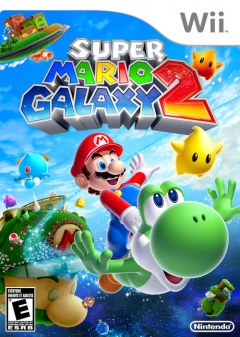 It has been a while since we've seen two core Mario series games on one Nintendo system in a while, you need to go back to the Super Nintendo with the two Super Mario Worlds for the last example, and it is highly arguable whether Yoshi's Island can be considered a core Mario game for that matter. Surprisingly, Nintendo announced Super Mario Galaxy 2 last year and the game was released this May to much herald and acclaim. Glancing at Metacritic, the top two games for the Wii are our two Galaxies, an incredible triumph for Nintendo.
It has been a while since we've seen two core Mario series games on one Nintendo system in a while, you need to go back to the Super Nintendo with the two Super Mario Worlds for the last example, and it is highly arguable whether Yoshi's Island can be considered a core Mario game for that matter. Surprisingly, Nintendo announced Super Mario Galaxy 2 last year and the game was released this May to much herald and acclaim. Glancing at Metacritic, the top two games for the Wii are our two Galaxies, an incredible triumph for Nintendo.
I actually beat Super Mario Galaxy 2 well over a month ago, but I decided, much like I did with the first Super Mario Galaxy, to wait until I had collected all 120 stars before writing a review. Actually, make that 240, no... 242 stars! Galaxy 2 more than doubles the collectible star count over the original while keeping the game both interesting and challenging. But is the game too much like the Super Mario Galaxy, or does it set itself apart enough to transcend the typical sequel failings we've been witness of lately?
For a look at the game's opening, check out Nate's first hour review of Super Mario Galaxy 2 published right after release.
